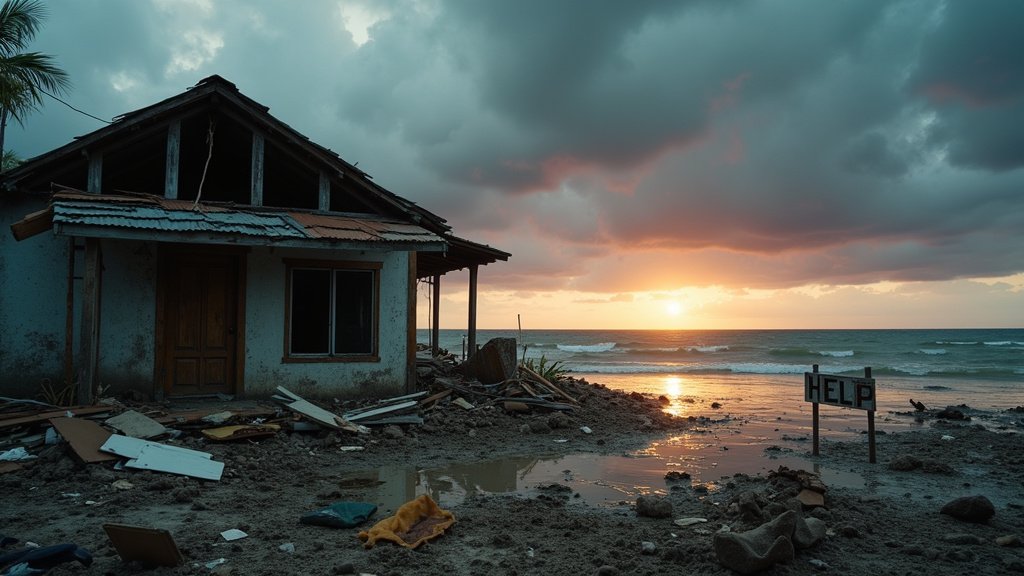Hurricane Melissa, a monstrous Category 5 storm, has carved a path of unprecedented devastation across the Caribbean, leaving a trail of death, destruction, and immense human suffering. The record-breaking hurricane made landfall in Jamaica with catastrophic force, subsequently battering Cuba and Haiti with torrential rains, destructive winds, and life-threatening storm surges. This global news event has resulted in a rapidly rising death toll, now exceeding 50 across the affected nations, and has plunged hundreds of thousands into darkness and despair.
Hurricane Melissa’s Devastating Path
On October 28, 2025, Hurricane Melissa made landfall in southwestern Jamaica as a Category 5 storm, packing sustained winds of 185 mph, making it the strongest hurricane ever recorded in the island’s history. The Saffir-Simpson Hurricane Wind Scale classification indicated winds of this magnitude have the potential for “total structural failure”. After crossing Jamaica, Melissa weakened slightly but remained a potent Category 3 hurricane when it struck eastern Cuba on October 29. The storm’s slow movement compounded its destructive impact, leading to catastrophic flooding, landslides, and extensive infrastructure collapse across multiple countries.
A Rising Death Toll and Widespread Loss
The human cost of Hurricane Melissa has been devastating, with confirmed fatalities mounting daily. As of October 31, reports indicated at least 19 deaths in Jamaica, while Haiti tragically reported over 30 fatalities, including children, and more than 20 people missing. The Dominican Republic also reported at least one death. In Haiti, the southern coastal town of Petit-Goâve was particularly hard-hit, with flooding collapsing dozens of homes and claiming many lives. Across the affected regions, countless homes were destroyed or severely damaged, leaving many residents homeless and reliant on emergency shelters.
Infrastructure in Ruins, Economic Fallout Mounts
The hurricane’s fury has crippled vital infrastructure across the Caribbean. Widespread power outages have left as much as 77% of Jamaica without electricity, and communication networks have been severely disrupted. Roads have been blocked by landslides and debris, isolating communities and hampering rescue and relief efforts. Initial estimates of the economic damage are staggering, with one forecaster estimating $48 billion to $52 billion in losses across the western Caribbean, while others suggest figures reaching as high as $8 billion for Jamaica alone [initial context, 13, 14, 24, 25].
Global Aid and Local Resilience in the Face of Disaster
In response to the unfolding crisis, a significant international and local effort is underway to provide humanitarian assistance and begin the long road to recovery. Venezuela has dispatched aid to Jamaica and Cuba. The United States has expressed solidarity and prepared to offer aid. Canada announced $7 million in funding for humanitarian assistance, allocating $5 million to partners for life-saving supplies and $2 million to the World Food Programme’s regional logistics hub in Jamaica.
International organizations are also mobilizing resources. The International Federation of Red Cross and Red Crescent Societies (IFRC) has dispatched humanitarian aid, including shelter kits, solar lamps, and tarpaulins, to Jamaica. UN agencies like the World Food Programme (WFP), UNICEF, and the Pan-American Health Organization (PAHO) are delivering food, water, medical supplies, and hygiene kits to affected populations in Jamaica, Cuba, and Haiti.
Jamaica, in particular, has been noted for its pre-existing financial preparedness, utilizing a mix of savings, credit lines, and insurance policies, including catastrophe bonds, to access funds quickly for recovery efforts. The Caribbean Catastrophe Risk Insurance Facility (CCRIF) announced a significant payout to Jamaica.
Climate Change and Amplified Storms
Scientists are increasingly pointing to the role of warmer ocean temperatures, exacerbated by climate change, in fueling the rapid intensification of storms like Melissa. Exceptionally warm sea surface temperatures provided Melissa with the energy needed to strengthen into a Category 5 hurricane, leading to predictions of heavier rainfall and more severe impacts at landfall. This growing trend highlights the increasing vulnerability of climate-sensitive regions to extreme weather events.
As recovery efforts continue, the full extent of Hurricane Melissa’s impact is still being assessed. The resilience of the affected communities is being tested, underscoring the critical need for sustained international support and robust disaster preparedness strategies in the face of increasingly powerful and frequent global weather phenomena.




